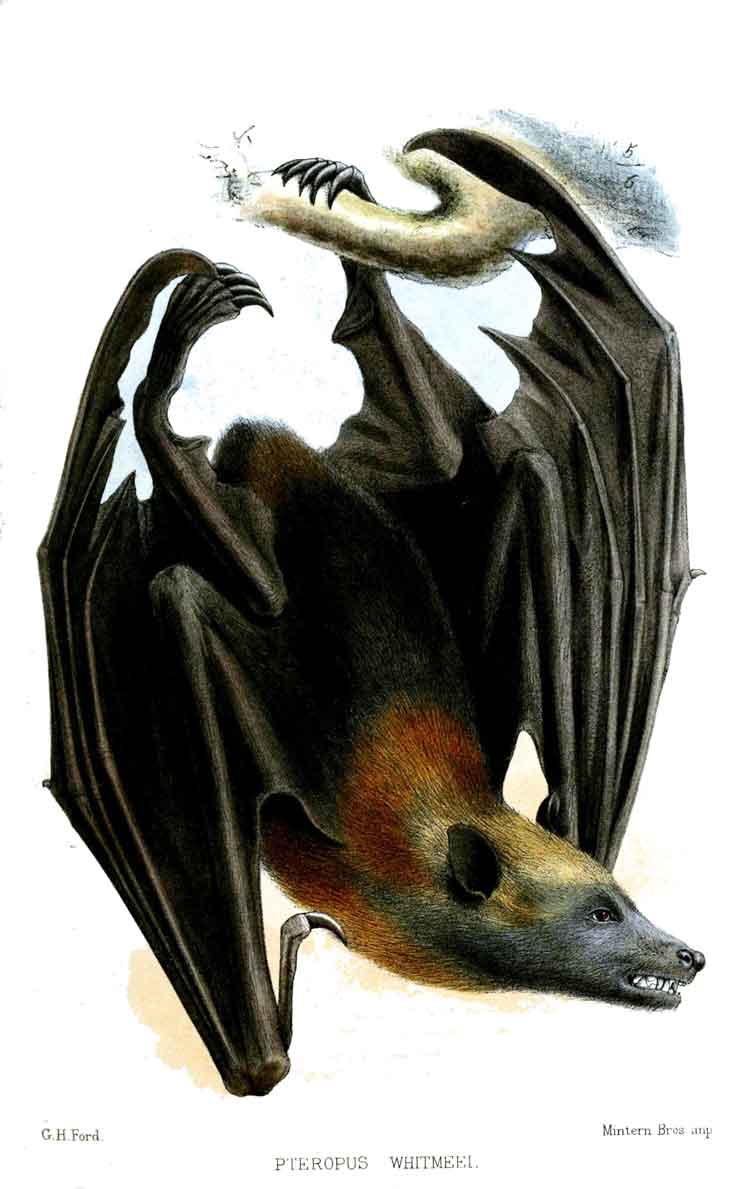
Superregnum: Eukaryota
Cladus: Unikonta
Cladus: Opisthokonta
Cladus: Holozoa
Regnum: Animalia
Subregnum: Eumetazoa
Cladus: Bilateria
Cladus: Nephrozoa
Superphylum: Deuterostomia
Phylum: Chordata
Subphylum: Vertebrata
Infraphylum: Gnathostomata
Megaclassis: Osteichthyes
Cladus: Sarcopterygii
Cladus: Rhipidistia
Cladus: Tetrapodomorpha
Cladus: Eotetrapodiformes
Cladus: Elpistostegalia
Superclassis: Tetrapoda
Cladus: Reptiliomorpha
Cladus: Amniota
Cladus: Synapsida
Cladus: Eupelycosauria
Cladus: Sphenacodontia
Cladus: Sphenacodontoidea
Cladus: Therapsida
Cladus: Theriodontia
Cladus: Cynodontia
Cladus: Eucynodontia
Cladus: Probainognathia
Cladus: Prozostrodontia
Cladus: Mammaliaformes
Classis: Mammalia
Subclassis: Trechnotheria
Infraclassis: Zatheria
Supercohors: Theria
Cohors: Eutheria
Infraclassis: Placentalia
Cladus: Boreoeutheria
Superordo: Laurasiatheria
Cladus: Scrotifera
Ordo: Chiroptera
Subordo: Yinpterochiroptera
Familia: Pteropodidae
Subfamilia: Pteropodinae
Tribus: Pteropodini
Genus: Pteropus
Species: Pteropus samoensis
Subspecies: P. s. nawaiensis – P. s. samoensis
Name
Pteropus samoensis Peale, 1848
Type locality: Samoan Islands, Tutuila Island (American Samoa).
References
Primary references
Peale, T.R. 1848 [1849?]. United States Exploring Expedition, during the years 1838, 1839, 1840, 1841, 1842. Under the command of Charles Wilkes, U. S. N. Vol. VIII. Mammalia and ornithology. C. Sherman: Philadelphia. Online Reference page. [p. 20]
Distribution
Fiji Islands
Samoan Islands
Vernacular names
Deutsch: Samoa-Flughund
English: Samoan Flying Fox
The Samoa flying fox or Samoan flying fox (Pteropus samoensis) is a species of flying fox in the family Pteropodidae. It is found in American Samoa, Fiji, and Samoa (where it is known as pe'a and pe'a vao). Its natural habitat is subtropical or tropical dry forests.
Description
The Samoan flying fox is a medium-sized bat weighing about 450 grams (16 oz) with a wingspan of about 0.86 metres (2 ft 10 in). It has a fox-like face with a pointed muzzle, a brown body and wings and the fur on its head and shoulders is blond or silvery-grey.[3]
Distribution and habitat
The Samoan flying fox is native to Fiji, Samoa and American Samoa. Its habitat is primary or secondary moist forest, plantations, agroforest and the vicinity of villages. Unlike most flying foxes, this species roosts alone or in small family groups.[1]
Biology
This bat is mostly diurnal, making foraging expeditions in early mornings and late afternoons. The diet consists mainly of fruit but leaves, flowers and nectar are also eaten. This bat is believed to be monogamous and males defend a territory of about 3 square kilometres (1.2 sq mi). A single offspring is born each year, usually in May or June. The juveniles begin to fly when they are about half the size of the adults, but may remain dependent on their mothers until three-quarters of her size.[3]
Status
The IUCN lists the Samoan flying fox as being "Near Threatened". Populations of this bat are thought to be in slow decline, but it has a wide range, and it is quite common within that range, and the rate of decline is believed not to be sufficient to justify putting it in a more-threatened category. The main threats it faces are forest clearance and the hunting of it for food. In the 1980s, it was killed commercially for export as a luxury food item, but a stop was put to that trade when it was listed in Appendix I of CITES in 1990.[1] This made it illegal to export it for commercial purposes, and hunting since then has been on a smaller scale and only for domestic use. It is present in some national parks and other protected areas which gives it some measure of protection.[1]
Samoan mythology
The Samoan word for the flying fox fruit bat, pe'a, is also the name of the traditional Samoan male tattoo. In Samoan and Polynesian mythologies, stories, myths, proverbs, and legends are associated with this winged creature.[4] One legend from the island of Savai'i in Samoa is about Nafanua, goddess of war; she was rescued by flying foxes when stranded on an inhospitable island,[5] similar to the goddess, Leutogi.
2020 American Samoa quarter
2020 American Samoa quarter featuring the Samoa flying fox
In 2018, the U.S. Mint had several candidate designs developed for the 2020 America the Beautiful National Park of American Samoa Quarter, which was in accordance with the act that authorized them. One of the designs features the familiar image of George Washington by John Flanagan, used on the quarter (heads) since 1932. The (tails) of the quarter features a Samoan fruit bat mother hanging in a tree with her pup. The image represents the remarkable care and energy that this species puts into their offspring. This design is intended to promote awareness to the threatened status of this species due to habitat loss and commercial hunting. The National Park of American Samoa is the only known park in the United States that is home to the Samoan fruit bat. The bats on the coins were designed by Richard Masters, who worked as Professor Emeritus at the University of Wisconsin Oshkosh's Department of Art. The designs were selected by the Citizen's Coinage Advisory Committee (CCAC) and the Commission on Fine Art (CFA). The coin was released to the public in February 2020, and will be followed by four other America the Beautiful quarters for the remainder of 2020.[6][7]
References
Scanlon, A.; Brooke, A.; Wiles, G. (2020). "Pteropus samoensis". IUCN Red List of Threatened Species. 2020: e.T18757A22087415. doi:10.2305/IUCN.UK.2020-2.RLTS.T18757A22087415.en. Retrieved 15 November 2021.
"Appendices | CITES". cites.org. Retrieved 2022-01-14.
Holmes, Stacie (2002). "Pteropus samoensis: Samoan flying fox". Animal Diversity Web. Retrieved 2013-12-08.
Vilsoni Hereniko; Rob Wilson (1999). Inside Out: Literature, Cultural Politics, and Identity in the New Pacific. Rowman & Littlefield. pp. 402–. ISBN 978-0-8476-9143-2.
Jeffrey Geiger (2007). Facing the Pacific: Polynesia and the American Imperial Imagination. University of Hawaii Press. pp. 155–. ISBN 978-0-8248-3066-3.
"American Samoa National Park |CCAC Images | U.S. Mint".
"2020 American Samoa Quarter Preview". 3 January 2020.
Retrieved from "http://en.wikipedia.org/"
All text is available under the terms of the GNU Free Documentation License

